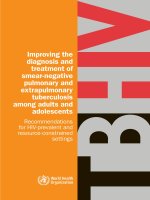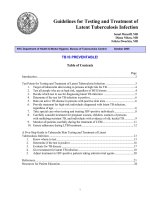Multifunctional nanoparticles of biodegradable polymers for diagnosis and treatment of cancer
Bạn đang xem bản rút gọn của tài liệu. Xem và tải ngay bản đầy đủ của tài liệu tại đây (3.64 MB, 210 trang )
MULTIFUNCTIONAL NANOPARTICLES OF
BIODEGRADABLE POLYMERS FOR DIAGNOSIS AND
TREATMENT OF CANCER
PAN JIE
NATIONAL UNIVERSITY OF SINGAPORE
2009
MULTIFUNCTIONAL NANOPARTICLES OF
BIODEGRADABLE POLYMERS FOR DIAGNOSIS AND
TREATMENT OF CANCER
PAN JIE
(M. ENG., TIANJIN UNIVERSITY)
A THESIS SUBMITTED FOR THE DEGREE OF DOCTOR OF
PHILOSOPHY DEPARTMENT OF CHEMICAL AND BIOMOLECULAR
ENGINEERING
NATIONAL UNIVERSITY OF SINGAPORE
2009
I
ACKNOWLEDGEMENT
First of all, I would like to express my deepest gratitude to my supervisor, A/P Feng
Si-Shen, for his heartfelt guidance, valuable suggestions, profound discussion and
encouragement throughout the entire period of this research work. His enthusiasm,
sincerity and dedication to scientific research have greatly impressed me and will
benefit me in my future career.
I am also thankful to my all colleagues and laboratory officers for their support and
assistance. In particular, thanks are due to Dr. Dong Yuancai, Dr. Zhang Zhiping, Ms.
Sun Bingfeng, Mr. Prashant Chandrasekharan, Ms. Anitha Panneerselvan, Mr. Liu
Yutao, Ms. Anbharasi Vanangamudi, Mr. Gan Chee Wee, Ms. Tan Mei Yee, Dinah,
and many other colleagues for their kind help and assistance. It is my great pleasure to
work with all of them. I am also indebted to the technical staff of Department of
Chemical & Biomolecular Engineering, especially Dr. Yuan Zeliang, Mr. Boey Kok
Hong , Mdm Lee Chai Keng, Mdm Li Xiang, Mdm Li Fengmei for their help and
support. The research scholarship provided by National University of Singapore is
also gratefully acknowledged.
Finally, I would like to express my deepest gratitude and indebtedness to my wife, my
parents, my daughter, my brother for their love and support.
II
TABLE OF CONTENTS
ACKNOWLEDGEMENT I
TABLE OF CONTENTS II
SUMMARY X
NOMENCLATURE XIII
LIST OF FIGURES XV
LIST OF TABLES XX
Chapter 1 Introduction 1
1.1 General background 1
1.2 Objective and thesis organization 3
Chapter 2 Literature Review 9
2.1 Nanocarriers for Cancer Therapy 9
2.1.1 Passive and active targeting 9
2.1.2 NP carriers for targeted therapy 10
2.1.2.1 Biodegradable polymer NPs 11
2.1.2.2 Liposomes 12
2.1.2.3 Dendrimers 13
2.1.2.4 Nucleic-acid-based NPs 13
2.1.2.5 Nanoshells 14
2.1.3 Targeting molecules for the development of targeted NPs 15
2.1.3.1 Folate-based targeting molecules 15
2.1.3.2 Monoclonal antibodies 16
2.1.3.3 Aptamer targeting molecules 17
2.1.3.4 Oligopeptide-based targeting molecules 19
III
2.2 Molecular Imaging 20
2.2.1 Introduction 20
2.2.2 Imaging modalities 22
2.2.2.1 Nuclear imaging 23
2.2.2.2 MR Imaging 25
2.2.2.3 Ultrasound 26
2.2.2.4 Optical Imaging 27
2.2.3 Molecular imaging of cancer 29
2.2.3.1 Cancer diagnosis and staging 29
2.2.3.2 Tumor characterization 31
2.2.3.3 Therapy assessment 31
2.2.4 Conclusions 32
2.3 QDs as Cellular Probes 33
2.3.1 Properties of QDs 33
2.3.2 Synthesis of quantum dots and QDs solubilization 35
2.3.3 Conjugating QDs with biomolecules 37
2.3.4 Cellular imaging and tracking 40
2.3.5 Tumor targeting and imaging 41
2.3.6 Cytotoxicity 42
2.3.7 Prospective 43
Chapter 3 Formulation, Characterization and In Vitro Evaluation of Quantum
Dots Loaded in Poly(lactide)-vitamin E TPGS Nanoparticles for Cellular and
Molecular Imaging 45
3.1 Introduction 45
3.2 Materials and Methods 50
IV
3.2.1 Materials 50
3.2.2 Synthesis of PLA-TPGS copolymer 51
3.2.3 Preparation of QDs-loaded PLA-TPGS NPs and MAA-coated QDs 51
3.2.4 Characterization of QDs-loaded PLA-TPGS NPs 52
3.2.4.1 Particle size analysis 52
3.2.4.2 Surface morphology 52
3.2.4.3 Surface chemistry of QDs-loaded PLA-TPGS NPs 53
3.2.5 Photophysical characterization 54
3.2.5.1 Fluorescent images 54
3.2.5.2 Emission spectra 54
3.2.5.3 The photostability 54
3.2.6 QDs encapsulation efficiency 55
3.2.7 Cell line experiment 55
3.2.7.1 Cell culture 55
3.2.7.2 In vitro cellular uptake of QDs-loaded PLA-TPGS NPs 56
3.2.7.3 In vitro cytotoxicity of QDs-loaded PLA-TPGS NPs 56
3.3 Result and Discussion 57
3.3.1 Characterization of the PLA-TPGS copolymer 57
3.3.2 Characterization of QDs-loaded PLA-TPGS NPs 58
3.3.2.1 Size and size distribution 58
3.3.2.2 Surface morphology 59
3.3.2.3 Surface chemistry of QDs-loaded PLA-TPGS NPs 61
3.3.3 Photophysical characterization 64
3.3.3.1 Fluorescent colors and emission spectra 64
3.3.3.2 Photostability 67
V
3.3.4 QDs encapsulation efficiency 69
3.3.5 In vitro evaluation 69
3.3.5.1 Cellular uptake of nanoparticles 69
3.3.5.2 In vitro cytotoxicity of QDs-loaded PLA-TPGS NPs 70
3.4 Conclusion 73
Chapter 4 Targeted Delivery of Paclitaxel Using Folate-decorated
Poly(lactide)-vitamin E TPGS Nanoparticles 75
4.1 Introduction 75
4.2 Materials and Methods 78
4.2.1 Materials 78
4.2.2 Synthesis and characterization of PLA-TPGS copolymer 79
4.2.3 Synthesis of TPGS-COOH and FOL-NH
2
80
4.2.4 Formulation of paclitaxel-loaded NPs with folate-decoration 81
4.2.5 Characterization of paclitaxel-loaded NPs with folate decoration 82
4.2.5.1 Particle size and size distribution 82
4.2.5.2 Surface charge 83
4.2.5.3 Surface morphology 83
4.2.5.4 Drug encapsulation efficiency 83
4.2.6 Surface chemistry 84
4.2.7 In vitro drug release kinetics 84
4.2.8 Cell cultures 84
4.2.9 In vitro cellular uptake of NPs 85
4.2.10 In vitro cytotoxicity 86
4.3 Results and Discussion 87
4.3.1 Characterization of PLA–TPGS copolymers 87
VI
4.3.2 Characterization of folate-decorated NPs 89
4.3.2.1 Size and size distribution 89
4.3.2.2 Surface charge 89
4.3.2.3 Surface morphology 90
4.3.2.4 Drug encapsulation efficiency 91
4.3.3 Surface chemistry 91
4.3.4 In vitro drug release 92
4.3.5 In vitro cellular uptake of NPs 93
4.3.6 In vitro cytotoxicity 97
4.4 Conclusion 99
Chapter 5 Targeting and Imaging Cancer Cells by Folate Decorated, Quantum
Dots Loaded Nanoparticles of Biodegradable Polymers 101
5.1 Introduction 101
5.2 Materials and Methods 106
5.2.1 Materials 106
5.2.2 Synthesis of TPGS-COOH and folate-NH
2
107
5.2.3 Formulation of QDs-loaded NPs with folate-decoration and free QDs
107
5.2.4 Characterization of QDs-loaded NPs with folate decoration 109
5.2.4.1 Particle size and size distribution 110
5.2.4.2 Surface charge 110
5.2.4.3 Surface morphology 110
5.2.4.4 Emission spectrum 110
5.2.4.5 QDs encapsulation efficiency 111
5.2.5 Surface chemistry 111
VII
5.2.6 Cell line experiment 112
5.2.6.1 Cell cultures 112
5.2.6.2 In vitro cellular uptake of NPs 112
5.2.6.3 In vitro cytotoxicity 113
5.3 Results and Discussion 114
5.3.1 Characterization of QDs-loaded NPs with folate decoration 114
5.3.1.1 Size and size distribution 114
5.3.1.2 Surface charge 115
5.3.1.3 Surface morphology 115
5.3.1.4 Emission Spectrum 116
5.3.1.5 QDs encapsulation efficiency 116
5.3.2 Surface chemistry 116
5.3.3 In vitro cellular uptake of NPs 117
5.3.4 In vitro cytotoxicity 119
5.4 Conclusion 123
Chapter 6 Multifunctional QDs/ Docetaxel -loaded Poly(lactic-co-glycolic acid)
Targeted Nanoparticles for Cancer Cell imaging and Therapy 125
6.1 Introduction 125
6.2 Materials and Methods 129
6.2.1. Materials 129
6.2.2 Synthesis of TPGS-COOH 130
6.2.3 Synthesis of FOL-NH
2
131
6.2.4 Preparation of QDs/docetaxel-loaded PLGA/TPGS-COOH NPs 131
6.2.5 Formulation of QDs/docetaxel-loaded PLGA/TPGS-COOH NPs with
FOL conjugation 132
VIII
6.2.6 Characterization of TC and FD NPs 133
6.2.6.1 Particle size and size distribution 133
6.2.6.2 Drug encapsulation and loading efficiency 134
6.2.6.3 Surface charge 134
6.2.6.4 Surface morphology 135
6.2.6.5 Surface chemistry 135
6.2.7 In vitro drug release 136
6.2.8 Photophysical characterization 136
6.2.8.1 Fluorescent images 136
6.2.8.2 Emission spectra 136
6.2.9 QDs encapsulation and loading efficiency 137
6.2.10 Cell line experiment 137
6.2.10.1 Cell cultures 137
6.2.10.2 In vitro cellular uptake of NPs 138
6.2.10.3 In vitro therapeutic effect and targeting effects 139
6.3 Results and Discussion 140
6.3.1 Characterization of QDs/docetaxel-loaded NPs 140
6.3.1.1 Particle size and size distribution 140
6.3.1.2 Drug encapsulation and loading efficiency 141
6.3.1.3. Surface charge 142
6.3.1.4. Surface morphology 142
6.3.1.5 Surface chemistry 143
6.3.1.6 In vitro drug release 144
6.3.2 Photophysical characterization of QDs/docetaxel-loaded NPs 146
6.3.2.1 Fluorescent images 146
IX
6.3.2.2 Emission spectra 146
6.3.3 Quantum dots encapsulation and loading efficiency 146
6.3.4 In vitro evaluation 147
6.3.4.1 In vitro cellular uptake of NPs 147
6.3.4.2 In vitro cytotoxicity 150
6.4 Conclusion 153
Chapter 7 Conclusions and Recommendations 156
7.1 Conclusions 156
7.2 Recommendations for Future Research 160
REFERENCES 162
LIST OF PUBLICATIONS 188
X
SUMMARY
Cancer is one of the major causes of mortality in the world, and the worldwide
incidence of cancer continues to increase. It is estimated that there will be 15 million
new cases every year by 2020. Drug delivery systems have captivated scientists and
engineers over the past many years because Drug delivery systems provide new
strategies for the delivery of biologically active compounds at the right dose, at the
right time and at the right place. Nanoparticles of biodegradable polymers are
composed of natural or synthesized macromolecules, which are compatible with the
human body (biocompatible) and are degradable under physiological condition into
harmless byproducts. While delivering the imaging/therapeutic agents to the diseased
cells, the polymeric matrix degrades and eventually disappears. The aims of this thesis
were to synthesize a novel copolymer, poly(lactide)– poly(lactide acid) -
d-α-tocopheryl polyethylene glycol 1000 succinate (PLA-TPGS) with desired
degradation rate and hydrophobic/hydrophilic balance and develop the copolymer
nanoparticles for cancer chemotherapy and imaging, as well as to prepare targeted
nanoparticles for cancer therapy and imaging using a new strategy that is the contents
of targeting ligands on the surface of nanoparticles can be controlled through
adjusting the component ratio of two polymers.
First of all, a novel system of poly(lactide acid) - d-α-tocopheryl polyethylene glycol
1000 succinate (PLA-TPGS) nanoparticles (NPs) for quantum dots (QDs) formulation
was developed to improve imaging effects and reduce side effects as well as to
promote a sustainable imaging. PLA-TPGS copolymers were successfully synthesized
by the ring-opening bulk polymerization of lactide monomer with TPGS in the
presence of stannous octoate as a catalyst. The QDs loaded copolymers nanoparticles
XI
were prepared by a modified solvent extraction/evaporation method. It was found that
the QDs formulated in the PLA-TPGS NPs can result in higher fluorescence intensity
and higher photostability than the bare QDs as well as lower cytotoxicity than the
MAA-coated QDs.
Nanoparticles (NPs) of the blend of two component polymers was also prepared by
the solvent extraction/evaporation single emulsion method and then decorated by
folate for targeted chemotherapy with paclitaxel used as model drug. One component
is poly(lactide) – d-α-tocopheryl polyethylene glycol succinate (PLA-TPGS), which is
of desired hydrophobic-lipophilic balance, and another is carboxyl-terminated
(TPGS-COOH), which facilitates conjugation with folate for targeting. The
PLA-TPGS is used to increase the half-life of the NPs in the blood system, and the
TPGS-COOH is used to facilitate the folate conjugation on the NP surface. It was
showed in this thesis that the nanoparticle formulation has great advantages vs the
pristine drug and the folate-decoration can significantly promote targeted delivery of
the drug to the corresponding cancer cells and thus enhance its therapeutic effects and
reduced its side effects.
Next, a new strategy was developed to prepare folate-decorated nanoparticles of
biodegradable polymers for QDs formulation for targeted and sustained imaging. In
order to reduce the cytotoxicity of QDs, two methods were used. One method is by
surface modification and polymeric nanoparticle formulation. Another method is by
targeted delivery of QDs, which can deliver QDs selectively to the cancer cells with
greater efficiency. These folate-decorated (FD) NPs encapsulating QDs can increase
biocompatibility and stability of QDs, prolong circulation time of QDs, and improve
the selective uptake and imaging specificity, sensitivity of cancer cells with minimal
XII
cytotoxicity to normal cells through selective delivery to appropriate tumor cell lines.
This technology can be helpful in molecular imaging and medical diagnostics,
especially the cancer detection in its early stage.
Finally, multifunctional NPs of biodegradable polymers loaded with QDs and
docetaxel for targeting, therapy and imaging were prepared and characterized. In this
study, docetaxel and quantum dots were employed as the model anticancer drug and
imaging agent, respectively. Nanoparticles of polymer blend containing PLGA and
TPGS-COOH were prepared using the nanoprecipitation approach and subsequently
decorated with folate for targeted drug delivery and imaging. These multifunctional
NPs were able to provide targeting effects on the sites of cancerous cells, reducing
side effects of docetaxel, enhancing docetaxel therapeutic effects and improving QDs
imaging specificity, sensitivity to cancer cells with minimal cytotoxicity to normal
cells.
XIII
NOMENCLATURE
ACN
AFM
AUC
BD
CLSM
CMC
DCM
D.I
DMEM
DMF
D
MSO
EE
FBS
FDA
FESEM
FT-
IR
GPC
HPLC
IC
50
LLS
MAA
MTT
Acetonitrile
Atomic force microscopy
Area under curve
Biodistribution
Confocal laser scanning microscopy
Critical micelle concentration
Dichloromethane
Deionized
Dulbecco’s modified eagle medium
Dimethylformamide
Dimethyl sulfoxide
Encapsulation efficiency
Fetal bovine serum
Food & Drug Administration
Field emission scanning electronic microscopy
Fourier transform infrared spectroscopy
Gel permeation chromatography
High performance liquid chromatography
The drug concentration at which 50% of the cell growth
is inhibited
Laser light scattering
Mercaptoacetic acid
3-(4,5-dimethylthiazol-2-yl)-2,5-
diphenyl tetrazolium
XIV
NMR
NP
PBS
PCL
PEG
PEO
P-
gp
PI
PLA
PLGA
PVA
RES
SEM
THF
TPGS
XPS
ZP
bromide
Nuclear magnetic resonance spectroscopy
Nanoparticle
Phosphate buffer solution
Poly(ε-caprolactone)
Poly(ethylene glycol)
Poly(ethylene oxide)
Polyglycol protein
Propidium iodide
Poly(D,L-lactide)
Poly(D,L-lactide-co-glycolide)
Poly(vinyl alcohol)
Reticuloendothelial system
Scanning electronic microscopy
Tetrahydrofuran
Vitamin E TPGS, d- -tocopheryl polyethylene glycol
1000 succinate
X-ray photoelectron spectroscopy
Zeta potential
XV
LIST OF FIGURES
Figure 3-1
Figure 3-2
Figure 3-3
Figure 3-4
Figure 3-5
Figure 3-6
Figure 3-7
Figure 3-8
Figure 3-9
Molecular structure of PLA-TPGS copolymer
Field emission scanning electron microscopy (FESEM) of
quantum dots-loaded PLA-TPGS nanoparticles
Atomic force microscopy (AFM) of quantum dots-loaded
PLA-TPGS nanoparticles
Transmission electron microscopy (TEM) of (A) the
quantum dots suspension and (B) the quantum dots-loaded
PLA-TPGS nanoparticles
X-ray photoelectron spectroscopy (XPS) C1s spectra of
(A) the pure PLA-TPGS copolymer and (B) the quantum
dots-loaded PLA-TPGS nanoparticles
X-ray photoelectron spectroscopy (XPS) spectra of the
quantum dots-loaded PLA-TPGS nanoparticles
Fourier transform infra-red spectroscopy (FTIR) spectra of
(a) the pure PLA-TPGS copolymer and (b) the quantum
dots-loaded PLA-TPGS nanoparticles
The fluorescent colors of the suspension of (a) the QDs in
n-Decane ([QDs] =0.21nM), (b) the QDs-loaded
PLA-TPGS nanoparticles in water ([QDs] =6.9nM), and
(c) the QDs-loaded PLA-TPGS nanoparticles in PBS
([QDs] =6.9nM)
Emission spectra of the QDs suspension and the
QDs-loaded PLA-
TPGS nanoparticles measured by (a)
58
59
60
61
62
63
64
65
66-67
XVI
Figure 3-10
Figure 3-11
Figure 3-12
Figure 4-1
Figure 4-2
Figure 4-3
Figure 4-4
Figure 4-5
microplate reader and (b) spectrofluorophotometer
Evolution relative emission intensities for the QDs-loaded
PLA-TPGS nanoparticles in PBS or in water and the QDs
suspension in n-Decane as function of the irradiation time.
Data represent mean (n=5) ± SD
Confocal laser scanni
ng microscopy (CLSM) of the
MCF-
7 cancer cells after 24h incubation with the
QDs-loaded PLA-TPGS NP suspension in DMEM at
0.25μg/μl NPs concentration. The images were obtained
from (A) the combined red channel and blue channel; (B)
the blue channel and (C) the red channel
MCF-7 cell viability after incubation with the QDs-loaded
PLA-TPGS NPs suspension and the MMA-coated QDs
after 1 day, 2 days and 3 days. Data represent mean (n=6)
± SD
Schematic representation for preparation of the
folate-decorated nanoparticles of the PLA-
TPGS and
TPGS-COOH copolymer blebs (FD NPs)
Molecular structure of the PLA-TPGS copolymer
1
H NMR spectra of the PLA-TPGS copolymer in CDCl
3
FESEM image of paclitaxel-
loaded, folate decorated
nanoparticles of 83.3% PLA-TPGS and 16.7%
TPGS-COOH (denoted by 16.7% FD NPs) prepared with
0.03% TPGS as emulsifier
The XPS wide scan spectra of the paclitaxel-loaded 0%,
68
70
72
82
88
88
90
92
XVII
Figure 4-6
Figure 4-7
Figure 4-8
Figure 4-9
Figure 5-1
Figure 5-2
Figure 5-3
Figure 5-4
9.1%, 16.7% and 33.3% FD NPs. The inset shows the
relative nitrogen signals at high resolution
In vitro paclitaxel release profiles from the FD NPs. Data
represent mean ±SD, n=3
(A) MCF-
7 and (B) C6 cells uptake efficiency of
coumarin 6-
loaded 16.7% TC NPs or 16.7% FD NPs at
the NPs concentration of 0.25mg/ml for 0.5, 1.0, 2.0, 4.0h,
respectively. (n=6)
Confocal microscopic images of MCF-7 cancer cells after
2h culture with (A-C) the coumarin-6-
loaded 16.7% TC
NP or (D-F) the 16.7% FD NP suspension at 0.125 mg/ml
NP concentration at 37 °C
In vitro viability of (A) MCF-7 and (B) C6 cells after 24h
(A1, B1) or 48h (A2, B2) t
reatment of paclitaxel
formulated in the 0% TC NPs, 16.7% FD NPs, 33.3% FD
NPs or in its current clinical dosage form Taxol
®
at the
same 25μg/ml drug concentration at 37 ºC (n=6)
Detailed scheme for preparation of QDs-loaded
PLA-TPGS/TPGS-COOH NPs with folate decoration
(A) FESEM image, (B) TEM image and (C) Emission
spectrum of QDs-loaded 11.1% FD NPs
The XPS wide scan spectra of the QDs-loaded FD NPs
with various copolymer blend ratio. The inset shows the
relative nitrogen signals at high resolution
Confocal laser scanning microscopy (CLSM) of (A)
93
95
96
98
109
115
117
118
XVIII
Figure 5-5
Figure 5-6
Figure 6-1
Figure 6-2
Figure 6-3
MCF-7 breast cancer cells treated with QDs-loaded 11.1%
TC NPs , (B) MCF-7 cells treated with QDs-loaded 11.1%
FD NPs and (C) NIH-3T3 cells treated with QDs-loaded
11.1% TC NPs , (D) NIH-
3T3 cells treated with
QDs-loaded 11.1% FD NPs at 0.38 nM QDs concentration
at 37 oC after 4 h incubation. Here green channel shows
the transmission images, while the intensity coded (red for
QDs and blue for DAPI) channel shows the fluorescence
In vitro viability of MCF-7 cells treated with free QDs,
QDs-loaded 11.1% TC NPs and QDs-
loaded 11.1% FD
NPs at the same 0.63 nM QDs concentration after 4 h and
24 h culture (n=6)
In vitro viability of NIH 3T3 cells treated with free QDs,
QDs-loaded 11.1% TC NPs and QDs-
loaded 11.1% FD
NPs at the same 0.63 nM QDs concentration after 4 h and
24 h culture (n=6).
Preparation scheme for folic acid-conjugated
PLGA/TPGS-COOH nanoparticles loaded with quantum
dots (QDs as a model imaging agent and docetaxel as a
model drug (FD NPs)
(A) Fluorescent Images of free QDs and those formulated
in the 16.7% FD NPs. (B) Emission spectra of free QDs
and those formulated in the 16.7% FD NPs. (C) FESEM
image and (D) TEM image of the 16.7% FD NPs (The
inset shows TEM image of free QDs)
XPS wide scan of QDs/docetaxel loaded
PLGA/TPGS-COOH NPs. The inset shows the relative
nitrogen signals at high resolution
121
123
133
143
144
XIX
Figure 6-4
Figure 6-5
Figure 6-6
Figure 6-7
Figure 6-8
In vitro docetaxe
l release profiles from the 0% TC NPs
(i.e. the PLGA NPs) and the 16.7% FD NPs. Data
represent mean ±SD, n=3
Cellular uptake of the 16.7% TC and 16.7% FD NPs by
(A) MCF-
7 and (B) NIH 3T3 cells incubated at the
equivalent QDs concentration of 0.75 nM for 0.5,1.0, 2.0,
4.0 h, respectively (n=6)
(A, upper row) Confocal microscopic images of MCF-7
breast cancer cells treated with (A1) the 16.7% TC NPs
and (A2) 16.7% FD NPs for 1h, respectively; (B, lower
row) Confocal microscopic images of NIH 3T3 cells
treated with (B1) the 16.7% TC NPs and (B2) 16.7% FD
NPs for 1h, respectively. The incubation was made at
equivalent 0.375 nM QDs concentration at 37
o
C. The
intensity coded (red for QDs and blue for DAPI) channel
shows the fluorescence
In vitro cell viability of MCF-
7 cells after 24, 48 and 72
hours incubation with various formulations at drug
concentrations of 0.025, 0.25 and 2.5 μg/ml
In vitro cell viability of MCF-7 cells at (A1) 0.025 μg/ml
drug concentration, (A2) 0.25 μg/ml drug concentration,
(A3) 2.5 μg/ml drug concentration after (B1) 24, (B2) 48
and (B3) 72 hours incubation (n=6)
145
148
149
151
151
XX
LIST OF TABLES
Table 2-1
Table 4-1
Table 5-1
Table 6-1
Table 6-2
Attributes of molecular imaging modalities
Characteristics of paclitaxel-loaded, folate-decorated
nanoparticles of the PLA-TPGS and TPGS-COOH
copolymer blend (BD NPs) at various blend ratio*
Characteristics of QDs-loaded NPs with or without
folate decoration at various blend ratio (n=6)
Characteristics of QDs/docetaxel loaded NPs with or
without folate decoration (n=3)
IC
50
23
of MCF-7 Cells after 24, 48, 72 hours incubation
with docetaxel formulated in Taxotere®, the TC- or FD
nanoparticles at various drug concentrations
89
114
141
152
1
Chapter 1 Introduction
1.1 General background
According to reports from the World Health Organization, cancer is one of the leading
causes of human mortality in the world, which leads about 13% of all deaths in 2007.
It was reported from American Cancer Society that 7.6 million people died from
cancer in the world during 2007. Cancer is a class of diseases in which a group of
cells display uncontrolled growth (division beyond the normal limits), invasion
(intrusion on and destruction of adjacent tissues), and sometimes metastasis (spread to
other locations in the body via lymph or blood) (
Different from cancer, benign tumors are self-limited, do not invade or metastasize.
Cancer may affect people at all ages, even fetuses. Cancer is the first-leading cause of
death in Singapore, and the proportion of cancer deaths in all causes of death was
27.7% in 2007 ().
Nanoparticles of biodegradable polymers are prepared from natural or synthesized
macromolecules, which are biocompatible and biodegradable under physiological
condition into harmless byproducts. After the imaging/therapeutic agents are
delivered to the diseased cells, the polymeric matrix gradually degrades and
eventually disappears. It is believed that biodegradable polymeric NPs can be
formulated to encapsulate poorly soluble drugs like paclitaxel and docetaxel, which
can enhance the solubility of the water insoluble drugs by tens to thousands of times.
2
Additionally, the advantages of polymeric nanoparticles include maintenance of
therapeutically effective drug level for prolonged time, protection of active agents
from in vivo degradation, facilitated passive targeting and active targeting upon
appropriate surface coating, reversion of multidrug resistance and so on. However,
once introduced into the blood, conventional nanoparticles (without surface
modification) will interact with blood proteins (opsonization) and are recognized as
foreign objects by the body defense system. Consequently, these nanoparticles are
captured by the macrophages in the reticuloendothelial system (RES) and then cleared
out from the circulation. In order to prolong systemic circulating half-life, the surface
of conventional nanoparticles are usually modified by grafting, conjugating, or
adsorbing sterically amphiphilic polymers such as poly(ethylene glycol) (PEG). The
formed hydrophilic and flexible PEG layer on the particles surface can be used to
prevent or minimize the recognition and clearance of the administered particles.
Compared to other drug delivery methods, these biodegradable polymer systems can
provide drug levels at an optimum range over a longer period of time, thus increasing
the efficacy of the drug and maximizing patient compliance, while enhancing the
ability to use highly toxic, poorly soluble, or relatively unstable drugs. Novel
biodegradable polymers/copolymers with desired prolonged residence time in the
circulation system and enhanced therapeutic efficacy of the loaded drug are thus
needed.
Currently, surgical intervention, radiation and chemotherapeutic drugs are widely
used methods for cancer treatments. But these approaches often also kill healthy cells
3
and lead to toxicity for the patients. Therefore, the development of chemotherapeutics
that can either passively or actively target cancerous cells will be expected. By
conjugating nanocarriers containing chemotherapeutics with molecules that bind to
overexpressed antigens or receptors on the target cells, active targeting can be
achieved. Targeting therapeutic approaches would significantly benefit from the
combination of targeted delivery with controlled release technology. This will
improve cancer therapy through delivering a large amount of drug to cancer cells per
targeting biorecognition event, and reaching a steady state cytotoxic drug
concentration at the tumor site over an extended period of time. In addition, the
harmful nonspecific side effects of chemotherapeutics can be reduced by this
approach since the drug is encapsulated and biologically unavailable during transit in
systemic circulation. Furthermore, formulation of these nanoparticles with imaging
contrast agents provides a very efficient system for cancer diagnostics and therapy.
Given the exhaustive possibilities available to polymeric nanoparticle chemistry,
research has quickly been directed at multi-functional nanoparticles, combining
tumour targeting, tumour therapy and tumour imaging in an all-in-one system,
providing a useful multi-modal approach in the battle against cancer.
1.2 Objective and thesis organization
The overall purpose in this thesis is to develop nanoparticles of biodegradable
polymers for molecular imaging and targeted therapy. In particular, the objectives of
this thesis include:









